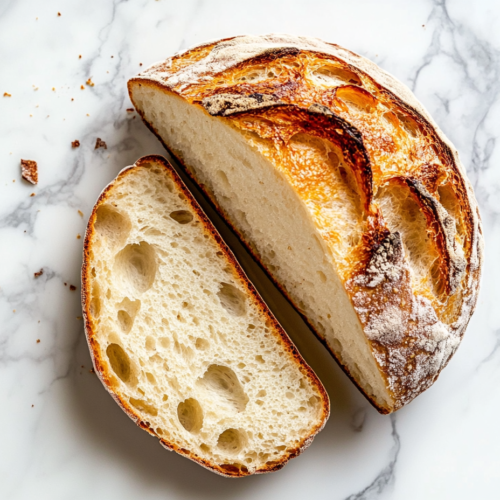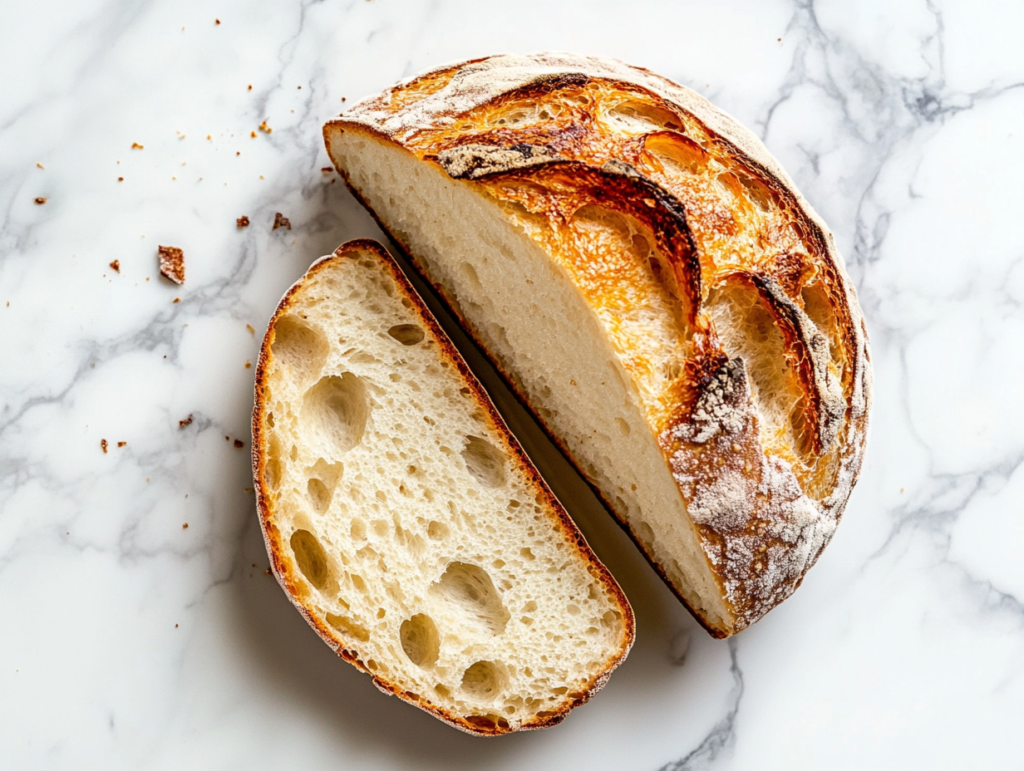Sourdough is more than just bread—it’s a story you bake, one slow rise at a time. Rooted in tradition yet endlessly adaptable, this recipe brings together the wild yeast magic of European kitchens with the cozy depth of Southern baking know-how.
The result? A crust that crackles, a crumb that’s tender and complex, and a flavor that tastes as good as my other bread recipes, like Homemade Bread and Raisin Pudding, and Honey Butter Sweet Potato Cornbread. Think tangy, toasty, and deeply comforting with every bite.
Once you get the rhythm of feeding your starter and stretching the dough, it becomes second nature—almost meditative. Whether you’re a seasoned baker or just sourdough-curious, this recipe welcomes you in with warm, flour-dusted arms.
Perfect For Autumn Afternoons!
- The flavor? Earthy, tangy, and just rustic enough to feel like home—every single time.
- I started baking this sourdough during a crisp fall weekend, and now it’s part of my seasonal rhythm—nothing pairs better with a bowl of butternut squash soup.
- There’s something grounding about the process in autumn: the cool air, the slower pace—it feels like the perfect time to nurture a loaf into life.
- I’ve shared warm slices with cinnamon butter during cozy porch brunches, and it always disappears faster than the apple cider.
- As the days get shorter, the scent of baking bread fills the house like a warm blanket—unexpectedly calming and endlessly nostalgic.

Sourdough Bread Recipe
Equipment
- Large mixing bowl
- Measuring cups and spoons
- Aluminum foil
- Proofing basket (banneton)
- Rice flour (for dusting basket)
- Rimmed baking sheet
Ingredients
- 394 grams bread flour
- 2 tbsp rice flour or as needed
- 8 grams kosher salt
- 250 grams water
- 100 grams active sourdough starter
Instructions
- Place the sourdough starter in a large bowl.
- Add flour, water, and salt; mix until sticky and well combined.
- Cover with foil and let rest at room temperature for 4 hours.
- Uncover, fold dough over itself 3–4 times with wet hands, cover again, and ferment for 2 hours.
- Meanwhile, dust a proofing basket with rice flour.
- Turn dough onto a lightly floured surface, shape into a smooth ball, and place it smooth side down in the basket.
- Pinch the top to seal.
- Cover and refrigerate for 12 hours.
- The next day, let dough sit at room temperature for 3–5 hours until it springs back slowly when poked.
- Preheat oven to 450°F and line a baking sheet with parchment.
- Dust dough with flour, invert onto the sheet, brush off excess, and score a shallow slit across the top.
- Lightly mist with water.
- Bake for 25–30 minutes until golden brown.
- Cool on a wire rack before slicing.
Notes
- Wet your hands before folding to prevent sticking without adding extra flour.
- Scoring the dough helps control the direction of oven spring and prevents random splitting.
- Rice flour in the proofing basket helps avoid sticking better than regular flour.
| Calories | 205kcal |
| Carbohydrates | 41g |
| Fiber | 2g |
| Fat | 1g |
| Protein | 7g |
Tips To Ease Your Job!
- Use a Digital Scale – Weighing ingredients gives better accuracy than cups and ensures consistent results.
- Autolyse for Flexibility – After mixing flour and water, let the dough rest for 20–30 minutes before adding salt and starter for easier kneading.
- Keep Hands Damp – Wet hands help handle sticky dough during folding without needing extra flour.
- Use a Bench Scraper – It makes shaping and transferring dough much easier and keeps your workspace tidy.
- Mark Fermentation Times – Set phone alarms or label your bowl with post-it notes to track proofing times precisely.



